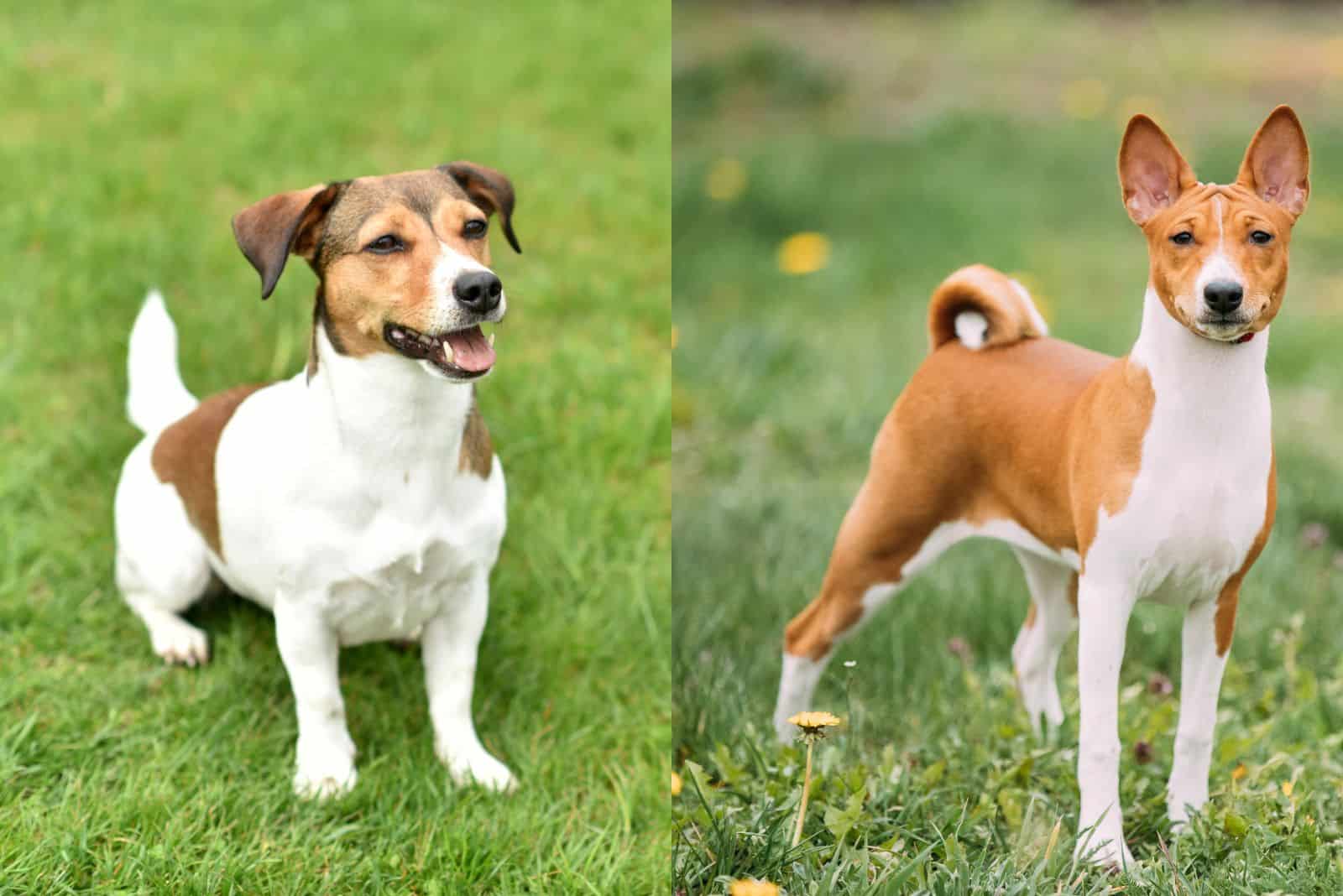Ever wished for a Terrier type dog who is not a prolific barker? Well, some unsung hero figured it out and decided to bless us with a Basenji Jack Russell mix. There are several features that make it stand out, and soon enough, we will get to the breakdown.
However, be warned that there are traits that make this mix a little bit difficult for first-time dog owners, so do not count your chickens before they are hatched. Overall, this mixed breed is an amazing companion that requires some special care.
Whether this is your first dog or not, you will have to be up to the challenge of finding, raising, and then enjoying this fascinating hound-terrier mix. It is information time!
Managing Expectations With The Basenji Jack Russell Mix

I like to think that a Terrier works best for people who like hunting or live on a property with acres of open space. Work ethic is strong with terrier-type dogs, so having a purpose makes life more enjoyable than watching TV.
A Basenji is a prolific hound dog that loves hunting and nose work but is much more individualistic and contained when it comes to “talking”. This is not to say they are mute, but the sound they produce instead of barking can be more pleasing to the ears.
Physically, it can be a game of halves — options are endless, but the main takeaway is that the mix will produce a small to medium-sized dog paired with either an athletic or more stocky body frame.
An eager expression, paired with semi-erect and constantly alert-looking ears, gives this designer dog a high level of desirability. It is an ideal dog for those who like spending their free time in the great outdoors, and apartment life does not make them tick.
Does Its Character Fit Your Lifestyle?
The Basenji Jack Russell mix can inherit either vocal feature. However, Terrier genetics seem to overpower many of these crossbreed combos, and the Jackenji (I made this name up) will most likely be a fearsome yapper.
When bored, a Basenji Jack Russell mix will stay close to you, hoping you will decide to go hiking or running any moment now. Following you around until you change your mind is a Russell trait, for sure.
Living with other dogs or smaller animals will be a chore. High prey drive is deeply embedded in the Basenji Jack Russell mix, and working against its genetics can prove to be too much effort with little reward.
This is not all, folks. I would be doing a disservice to the mix if you based your opinion or decision on this general information, so join me in telling you about its physical and temperament features in detail.
Basenji Jack Russell Terrier Mixes Are Built To Last
Reaching heights of up to sixteen inches and a maximum weight of around twenty-five pounds, the Jackenji is a dog of substantial weight for a small to medium breed. Its frame is often a combination of both breeds, but the Basenji’s legs seem to dominate the mix.
This means that a Basenji will have a slightly stouter body with slim legs, and that is not a bad thing for a dog that loves activity. A slim upper with shorter but thicker legs is equally possible, but complete dominance of one parent breed’s physical features is not ruled out.
The neck is muscular and longer than average, thanks to the Terrier parent breed, but the Basenji ear genes playing tug of war with the Terrier floppers usually result in a half-flopper.
Basenji Jack Russell mixes have a short to medium-length muzzle that slightly narrows towards the nose. Eyes are most often of a dark color and are almond-shaped. The brow bone might slightly overarch, but not as pronounced as in a purebred Russell Terrier.
Since its body is built for work and action, both front and back legs are muscular, with an effortless and elegant gait. A flat back that ends in a curved tail is right in the middle between a Jack Russell Terrier and a Basenji.
In most cases, the tail is comfortably curved over the back. Your particular Jackenji might have a straighter tail, though, but do not be surprised if it is tilted to the side like in a purebred Basenji.
Coat Quality, Grooming, And Color Possibilities
The mix is balanced in terms of coat quality, so a Basenji Jack Russell mix will always have a short coat with smooth hair quality. The Russell can have a wiry coat, but it rarely translates into the mix.
An undercoat is not present, so the athletic look of the dog is further accentuated with a coat placed tightly to the skin. This means that grooming will be an easy task.
Brushing once or twice a week is more than enough, and during transitional periods, there will not be many hairs flying around the house. Because the coat is short, getting the hair out of clothes can sometimes be frustrating.
The coat color in the Basenji Jack Russell mix brings a victory for the Basenji parent. Nine coat color options and a few patterns are further stylized by four possible markings, such as a black mask, black saddle, with cap, and brindle markings.
An all-white Basenji Jack Russell mix is rare, despite the Russell Terrier’s predominantly white color. The JRT contributes to the markings department with five options, including a tri-color. The most common color is the reddish Basenji classic.
Into The Mind Of The Jack Russell Basenji Mix

Though great dogs for active people, the Jackenji mix temperament can be too high energy for people who are often away from home or prefer relaxing on the sofa instead of taking trips to the mountain or seaside.
The Basenji Jack Russell mix is a small dog that requires Labrador or German shepherd levels of activity. It is a highly intelligent dog that, ironically, is not easy to train.
See Also: Jack Russell Lab Mix: You Will Adore The Jackador
This mix knows what it wants, and the attention span might be on the lower side if you keep insisting on doing things that are of no interest to it. This stubbornness can be an insurmountable obstacle for first-time dog owners, so keep that in mind.
A Jackenji can easily get bored, and eating away your home one bite at a time will be a breeze if left alone for long periods of time. Make sure you keep them entertained in as many ways as possible if left alone in the house.
Barking is a Terrier specialty, but the Basenji dog is a yodeling master that sings only when the venue is full. No random gigs in the middle of the night when you are recovering from “playtime” with these activity buffs.
The Russell Basenji mix will probably be an okayish watchdog, so do not put all of your eggs into one basket if you want a dog with good protective instinct. You would be better off with a Chihuahua in this case.
Socialization
Depending on which parent breed it took the temperament from, you might get a dog that does well without your company, which would probably mean it is more Basenji in terms of individuality.
Every dog lover who owns a Basenji, a Jack Russell, or the mixed-breed dog version of those two, will tell you that they are good family dogs, but only if properly taken care of.
The Basenji Jack Russell mix does not like having other dogs around. Even though they would love small animals to chase around the house, I doubt many owners would welcome the thought of their hamster or cat being under duress every single day.
As with many Basenji mixes, early socialization of your Jackenji puppy is key to preventing unwanted behavior. Obedience training and proper exercise can significantly lower the chances of pet conflict in your home.
If you have small children or have guests often, this might not be the best dog for you. A Russell Basenji mix likes its own space and plays on its own terms. They are not particularly playful dogs either, but that mainly depends on which side of the family they inherited their temperament.
Basenji Jack Russell Mix Health Problems

Different dogs mixed into one package carry their own baggage. For this particular mix, there are some diseases that occur more frequently than in others and knowing that before getting a dog is of paramount importance.
Although most of these are congenital, avoiding shady breeders can save you a lot of trouble and money. One can never know for sure that a genetic disease will not catch up with your dog, so informing yourself about what it is and how to deal with it can be a lifesaver.
Immunoproliferative small intestinal disease (IPSID)
This is a disease that prefers Basenji dogs more than any other dog breed. It is a variant of irritable bowel syndrome that can be stress-induced or congenital. The concrete reasons why it occurs more frequently in this breed are still unknown.
The most common symptoms include weight loss, chronic diarrhea, and vomiting. Treatment consists of diet changes, antibiotics, and steroidal medicine.
Fanconi Syndrome
Again, the Basenji is the most frequently affected dog breed when it comes to Fanconi syndrome. This condition is a kidney disorder that makes the tubules in the kidneys not process nutrients correctly.
Electrolytes and other vital vitamins and minerals are not reabsorbed into the body, so they are removed through the urine. The electrolyte, vitamin, and mineral deficiency caused by Fanconi syndrome can have severe consequences if left untreated.
Usual symptoms include lethargy, weight loss, coat degradation, and poor physical condition. Without a cure, the only treatment options are diet adaptation and supplemental medicine.
Hip Dysplasia
Mixed breeds often suffer from hip and elbow dysplasia because genetics is a finicky business we have not mastered yet. For a dog as active as the Basenji Jack Russell mix, this condition can be a death sentence.
During the puppy’s growth period, the ball and socket of the hip joint do not develop properly, and the anatomical abnormality causes the cartilage to wear off during movement. When bone tissues start grinding against each other, the damage ultimately leads to arthritis.
No cure exists for hip dysplasia, and treatment options include medication in the form of NSAIDs or surgery in more severe cases.
Progressive Retinal Atrophy (PRA)
While this is a mix of conditions that cause eye problems, the progressive nature of it means that it cannot be cured. Usually congenital but also caused by cancer or eye trauma, the disease is characterized by the deterioration of the retina.
This part of the eye is directly connected to the eye nerve that transfers the projected image into the brain, so blindness is inevitable when PRA reaches its end stage. Symptoms include loss of night vision, loss of central vision, avoidance of physical activity, etc.
Secondary care, such as adapting the environment to the dog and easing the major lifestyle change, is the only possible treatment. Slowing down the progression is sometimes successful with proper supplemental medicine incorporated into the dog’s diet.
What Is The Lifespan Of The Basenji Jack Russell Mix?
Both parent breeds have a relatively long life expectancy, so the mix ought to live by your side for thirteen to sixteen years. Many things can shorten or prolong the lifespan, so make sure you get your mix from a reputable breeder.
Regular vet checkups, good eating habits, and a quality diet all play a major role in making sure your dog lives the longest possible life.
Overview Of The Jack Russell Terrier And Basenji

With some blanks left to fill in regarding potential mix traits, there is no better way to address it than talk about the parents. A short history of both breeds, followed by a breakdown of physical and temperament traits, should be enough for a final decision.
The African Barkless Dog
So many impressive milestones are directly connected to this dog breed. It is considered to be the oldest dog breed known to man, a dog that does not bark, and it is one of the fiercest small dog breeds.
Getting its image onto ancient tablets from Mesopotamia and Babylon must have warranted some impressive feats. The translation of Basenji is “the jumping-up-and-down dog,” so I guess ancient civilizations took a leap with getting in the good books of the breed.
Basenjis had a tough start to life in the Western world. After several attempts to produce bloodlines of European origin, the British decided to give their only Basenji male to a breeder in Boston, who managed to establish the first American-bred Basenji litter in the 1950s.
Interestingly, the Basenji belongs to the hound category of dog. Comparing it with another hound dog, such as the Beagle, shows how diverse the classification of dogs was between continents.
Hunter Extraordinaire
There are many types of terriers in the world. The Rat terrier, Fox terrier, Parson Russell, Staffordshire Terrier, etc., but the Jack Russell is one of the most internationally acclaimed fox hunting companions.
Though the Parson Russell and Jack Russell Terrier both have very similar heritage, the Jack Russell’s size made it the perfect hunting dog. It could follow the pace of bigger, faster dogs but with the ability to burrow and smoke out underground-dwelling animals.
It has performed admirably in this role since the nineteenth century, creating a reputation that is unprecedented in the world of terriers. It adapted to the new role of companion dog almost seamlessly, which means that its true role was always pleasing its owner.
Read Also: 10 Most Reputable Parson Russell Terrier Breeders In The USA
Basenji And Jack Russell Terrier Pictionary
The Basenji is larger than the Jack Russell at seventeen inches in height and twenty-four pounds in weight. The terrier’s role impacted the way it was bred, so a height of ten to twelve inches and a rather low weight of nine to fifteen pounds was a career choice.
The athletic and aerodynamic body frame of the Basenji contrasts the Jack Russell’s square and stout silhouette. The latter has thicker bones and a shorter muzzle for foraging through dens.
Both dogs are muscular, but the Jack Russell has a slightly more developed front and hindquarters. The compressible chest is a trademark of the terrier, while the Basenji sports a less wide front body.
The stop is pronounced in the Jack Russell, giving the entire head a squarish appearance. On the other hand, the Basenji has a subtle stop that narrows towards the nose. Both breeds have straight backs that end in tails with a quite different story.
The Basenji tail is curled and slanted to the side, while the Jack Russell’s tail ends at a point and is slightly curved while the dog is alert. Ears are triangular in shape and hang by the sides in JRTs, but the Basenji has fully erect forward-placed pointy ears.
Coat Quality And Colors
A short, smooth single coat is present in both breeds, but the Jack Russell can have a wiry coat just slightly longer than the Basenji’s. Neither dog requires intense grooming, but the wiry coat may be a twice-a-week job.
The American Kennel Club recognizes white as the only standard Jack Russell color, alongside five markings. Regarding Basenji colors, the AKC recognizes four colors as a breed standard, and only the brindle markings out of four possibilities.
Keep in mind that Jack Russells come in different colors despite the AKC recognizing only white. Have a read about the twelve colors and patterns Jack Russells often sport. This other one is a detailed article on Basenji standard colors and markings.
A Russell Terrier will have bushier brows and a beard, whereas the Basenji is a smooth shave all around. Markings on the chest, feet, tip of the tail, and forehead are a traditional look for the Basenji.
Jumping And Digging Make For Happy Living
Character-wise, these two dog breeds are kind of opposites. The JRT is a barking, playful, high-energy dog that packs a punch. Basenjis are medium-energy dogs that like doing their job and do not play that much.
This does not mean you can just leave your Basenji at home and it will take care of itself. Well, in some aspects, it will. They are often compared to cats for their self-grooming etiquette. Their bark is closer to a yodel than a bark, and it is used only when absolutely necessary.
A Jack Russell will bark whenever excited, playful, alert, and in other situations that you might consider bark inappropriate. Basenjis love open areas, and no matter how large your yard is, it will probably jump over and make a run for it.
Being terriers, JRTs will dig instead of jump but are not as problematic to keep within a yard as their hound colleagues. A Jack Russell will require more attention than a Basenji, which means there is a greater chance of separation anxiety.
Jack Russell Terriers are better family dogs than Basenjis simply because they tolerate children and strangers much better. While neither breed is overly fond of other dogs, the Basenji is less trainable and sociable than the Jack.
Watchdog instinct is stronger in the JRT because they usually form a closer relationship with the owner and their family. Basenjis are free spirits that like to serve themselves and then the community.
Conclusion
Straight off the bat, the Basenji Jack Russell mix is not for everyone. If you want a fun, cuddly, playful family dog, you are better off choosing a different breed or mix. We have a lengthy list of dog breeds that perfectly fit the bill.
Getting a Basenji Jack Russell mix is not easy, despite its rise in popularity. Breeders can charge a premium, and the scarcity of JRT Basenji mix puppies allows backyard breeders and puppy mills to scam people.
Reputable breeders will show you health and bloodline certificates, photos, answer any of your questions, and more. If you do not receive the full service, stay away from that “breeder”.
I hope you had fun reading about the Jackenji. See you in the next one.
